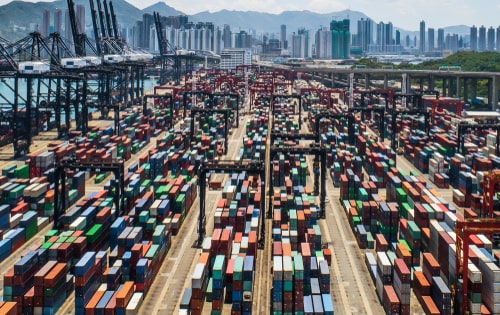
Trade conflict is proliferating while structural challenges have deepened. Business sentiment is on the decline. The World Trade Organization (WTO) could be at risk. Uncertainties associated with these tensions have already hit business and investor confidence. Large disruptions to global value chain operations could occur.
Analysis by Russell Group shows that this disruption is concentrated within six of the world’s largest ports, which are vulnerable to increasing geopolitical and windstorm risk, with a combined exposure of $1.14 trillion (based on H2 period figures). The trade volumes of each port [see table below] easily exceeds $100 billion, according to analysis by Russell Group.
Trade Volumes of World’s Largest Ports
1. Hong Kong South China Sea 288,344,259,030
2. Singapore Malacca Strait 255,115,709,919
3. Long Beach Pacific Ocean 186,092,831,162
4. Los Angeles Pacific Ocean 126,777,695,335
5. Houston Gulf of Mexico 179,465,796,238
6. STS Area Tsushima Sea of Japan 104,068,219,968
Hong Kong, currently at the eye of a geo-political storm cloud, heads the list of ports over the H2 period, with $288 billion of trade passing through with Singapore coming in not far behind with $255 billion. Houston, meanwhile, which lies at the heart of U.S. global shipping is potentially exposed to nearly $188 billion of Gulf of Mexico windstorm risk as we enter the midpoint of the hurricane season.
Hong Kong, Singapore, Long Beach, Los Angeles, Houston and Tsushima ports serve shipping fleets across the South China Sea, Malacca Strait, Pacific Ocean, Gulf of Mexico and Sea of Japan but all have one thing in common – they are all connected by a global policy outlook for trade and investment that has darkened over the past year.
As the centre of geopolitical instability shifts to Asia, the South China Sea carries tremendous strategic importance; one-third of the world's shipping by volume passes through it, carrying over $3 trillion in trade each year. Huge oil and gas reserves are believed to lie beneath its seabed.
Both China and Taiwan claim almost the entire body as their own, demarcating their claims within what is known as the nine-dotted line, which claims overlap with virtually every other country in the region. Competing claims include:
Houston, meanwhile, is the artery that keeps America’s heart pumping. The cost of a new Hurricane Harvey hitting the Houston shipping canal in 2020 would be devastating. This is because the 52-mile channel links up 130 of the USA’s major refining and petrochemical companies (including ExxonMobil, Chevron and Shell) to the Gulf of Mexico and acts as a conduit for key products, such as plastics and pesticides to other areas across the USA.
Russell Group has been exploring the impact of connected risk across the specialty classes for some time including the effect on trade from other connected risks such as natural perils, supply chain, and geopolitical.
Meanwhile, supply chain risk is clearly of paramount concern in today’s global world of “just in time” techniques and the incorporation of supply chain data to link back to exporting/importing assureds, enables such risk to be quantified. Furthermore, through detailed data linkage it is also possible to assess the geopolitical impact on ship movement and cargo trade flow.

Related Articles
Marine
Marine
Marine